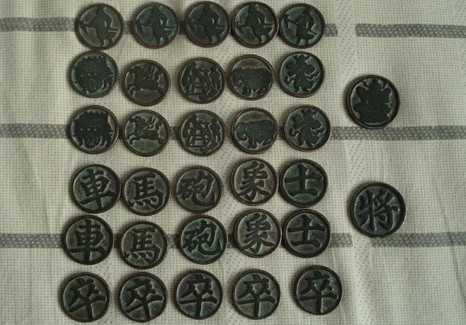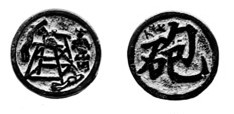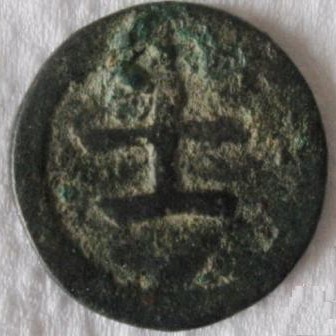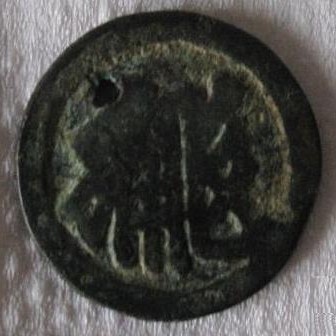BabelStone Blog
Thursday, 24 July 2008
Tangut Chess
As I hinted at in my previous post, the history of Chinese Chess (Xiangqi 象棋) does not go back nearly as far as that of Go or even Backgammon. There is no convincing evidence that any form of chess was played in China before the Tang dynasty (618-907), and even during the Tang dynasty there is only very limited documentary evidence for the game, and no certain archeological evidence, so it does not seem to have been widely played before the Song dynasty (960-1279).
However, by the end of the Northern Song (960-1127) Chinese Chess had become extremely popular, and not only is there unambiguous documentary evidence for the game, but large numbers of Chinese Chess pieces in a variety of materials (pottery, porcelain, wood and bronze), dating from both the Northern Song (960-1127) and the Southern Song (1127-1279), as well as the Yuan dynasty (1271-1368), have been found, including several complete sets of bronze Chinese Chess pieces. The complete set of thirty-two bronze Chinese Chess pieces shown below were found in Inner Mongolia, and date to the Northern Song period.
Set of Northern Song Bronze Chinese Chess Pieces

Source : 中国文物收藏交易网
Each piece is about 2.5 cm in diameter (although the Generals are a little bigger), and has a Chinese character on one side and a picture on the other, which is typical of Song dynasty bronze Chinese Chess pieces. What is less typical is the fact that the Chinese characters are the same for both players (the general which is face down in the picture above is also a jiàng 將), which may indicate that differentiated characters for black and red were a later development.
The other interesting fact about this set is that it was found in Inner Mongolia, on or beyond the borders of the Song empire. In fact, quite a few examples of Chinese chess pieces have been found in peripheral parts of China, such as this beautiful example of a Catapult (pào 砲) piece that was found in the ruins of the Silk Road oasis city of Gaochang 高昌 by Albert von Le Coq (1860-1930) during his expedition of 1904-1905.
"Catapult" piece found at Gaochang

Source : Chotscho [Facsimile Reproduction of Important Findings of the First Royal Prussian Expedition to Turfan in East Turkistan] (1913) vol.1 page 218
It seems likely from finds such as these that Chinese Chess was played not only in China but also in neighbouring territories, such as those under the control of the Khitans, Jurchens, and Tanguts, but until now there has been no evidence of specific Jurchen, Khitan or Tangut versions of Chinese Chess. However, in March of this year a find of great interest to me, both as an amateur historian of Chinese games and as a student Tangutologist, was reported : in October 2002 a coin collector had bought some old coins from some peasants at a coin market in the city of Wuwei 武威 in Gansu province, and when he recently took them to the Wuwei Museum for identification and valuation it was found that among the Song and and Western Xia coins there was also a single bronze Chinese Chess piece with a Chinese inscription on one side and a Tangut inscription on the other (the reports state that this is the first ever Chinese Chess piece with a Tangut inscription to have been found within China, which suggests the possibility that other examples have been found outside of China, but I do not know of any other examples) :
Chinese Chess Piece with Chinese and Tangut Inscriptions


The diameter of this piece is 2.5 cm, which is the same as the Northern Song bronze Chinese Chess pieces shown above. But unlike those pieces it has a Tangut character on the opposite side to the Chinese character, not a pictorial representation of the piece. According to the Chinese character on one side this piece is a shì 士, one of a pair of weak pieces that defend the General in his palace. The Chinese character does not have a clear and definite meaning in isolation, and so it is difficult to translate, being variously called "advisor", "guard", "minister", "assistant", "mandarin" or "warrior" in English. So it is interesting to see what the Tangut equivalent of a shì 士 is. Well, the Tangut character is relatively clear, and can be identified as
𘙶
Li Fanwen 0624, Kychanov 5582
which has a reconstructed reading of [rẹ], and by itself means "strip" 條 (Li Fanwen 1997) or "branch, row, file, formation, chief of a formation, chapter, strip" 挑 列 數號 隊形 隊形長 卷 條 (Kychanov 2006). Like many Tangut characters, its meaning is reflected in its structural composition. The left part of the character is the left part of a character that means "long", and the right part of the character is by itself a character that means "narrow", so "long and narrow" equals "strip" :
𘙶 = 𘙲 + 𗇅
At first sight this is rather an odd name for a chess piece, and seems to bear no relationship to the Chinese character on the other side. But as an extension of its basic meaning "strip" the character also means "formation" or "column" of soldiers, and in this sense it combines with a character meaning "chief" (Li Fanwen 3266, Kychanov 0198) to form a compound word meaning a "general" :
𘙶𗦳
[rẹ ndzi̯u] "general" 將
Then, a semantic shift appears to have taken place, and the character takes on the meaning of "general" when it occurs as the first element in the following two compound words, modified by the adjectives "main" (Li Fanwen 1836, Kychanov 1911) and "assistant" or "deputy" (Li Fanwen 2705, Kychanov 4219) respectively :
𘙶𗹑
[rẹ tśi̯e] "main general" 正將
𘙶𗡼
[rẹ mbi̯ẹ] "lieutenant general" 副將
Therefore we can assume that the Tangut character shown on this chess piece is an abbreviation for one of these compound words, meaning either "general" or "lieutenant general". This seems somewhat distant from the possible range of meanings of the Chinese word shì 士, but does immediately make me think of Japanese Chess (shōgi 将棋) where the place of the shì 士 of Chinese Chess is taken by a Gold General (kinshō 金将). Is it just possible that the Tangut version of Chess was perhaps intermediate between Chinese Chess and Japanese Chess ?
What else do we know about Tangut chess ? Well, from the dictionaries we learn that the Tangut word for Chinese Chess and/or a Chess piece (Li Fanwen 5445, Kychanov 3781) is
𘐑
[ri̯ẹ] "chess-game, chessman, chess-horse" (Kychanov 2006)
This character is also easy to analyse. The lefthand element occurs in a number of characters that have meanings related to chess or gaming (Li Fanwen 5216, 1792, 4227, and Kychanov 3667, 3192, 5000), and in particular it is also the lefthand element in the following character meaning "to play chess" (Li Fanwen 5216, Kychanov 3667) that together with the above character forms a compound word meaning "Chinese (?) Chess" [li̯u ri̯ẹ] :
𘐁
[li̯u] "chess" (Kychanov 2006)
The righthand element is simply the character meaning "horse" (Li Fanwen 0764, Kychanov 3772) :
𘆝
[ri̯ẹ] "horse"
And as the character on the chess piece also shares exactly the same reading as the word for "horse" [ri̯ẹ] we can assume that the two words are etymologically the same, and that the Tangut word for "Chinese Chess" is not Elephant Chess (xiàngqí 象棋) as it is in Chinese, but Horse Chess. So perhaps the Tangut version of the game does not have an elephant piece, but puts more emphasis on the horse piece. But this is all just speculation, and I await the hopeful discovery of a complete set of Tangut Chess pieces one day ...
Last modified: 2017-01-01 (updated with Unicode Tangut characters)
If Tangut characters do not display correctly, please download and install the Tangut Yinchuan font.
Index of BabelStone Blog Posts